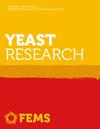白色念珠菌线粒体复合体 I 缺乏可通过抑制性 TOR 和 PKA 途径使细胞周期停滞在 S 期
IF 2.4
4区 生物学
Q3 BIOTECHNOLOGY & APPLIED MICROBIOLOGY
引用次数: 0
摘要
本研究调查了线粒体电子传递链(ETC)蛋白的突变如何影响白色念珠菌的细胞周期。利用针对 ETC 复合物 I(CI)、III(CIII)和 IV(CIV)的基因空突变体,通过荧光激活细胞分拣(FACS)分析了细胞周期阶段(G0/G1、S 期和 G2/M)。四个 CI 空突变体表现出明显的变化,包括 S 期延长、G2/M 群体缩短以及细胞体积缩小超过 10 μM。相反,CIII突变体在G1/G0期的细胞数量增加。在四个CI突变体中,ndh51Δ/Δ和goa1Δ/Δ显示出与先前报道的cAMP/PKA下调相关的异常细胞周期模式。具体来说,nuo1Δ/Δ 和 nuo2Δ/Δ 突变体的 RIM15 转录增加,RIM15 是连接细胞周期与营养依赖性 TOR1 和 cAMP/PKA 通路以及 Snf1 衰老通路的中心枢纽。这些发现表明,TOR1 和 cAMP/PKA 通路的抑制或 Snf1 的增强会扰乱细胞周期的进展,从而影响 CI 突变体的细胞寿命和生长。总之,我们的研究强调了线粒体 ETC、细胞周期和信号通路之间错综复杂的相互作用。本文章由计算机程序翻译,如有差异,请以英文原文为准。
Mitochondria complex I deficiency in Candida albicans arrests the cell cycle at S phase through suppressive TOR and PKA pathways
How mutations in mitochondrial electron transport chain (ETC) proteins impact the cell cycle of Candida albicans was investigated in this study. Using genetic null mutants targeting ETC complexes I (CI), III (CIII), and IV (CIV), the cell cycle stages (G0/G1, S-phase, and G2/M) were analyzed via fluorescence-activated cell sorting (FACS). Four CI null mutants exhibited distinct alterations, including extended S- phase, shortened G2/M population and a reduction in cells size exceeding 10 μM. Conversely, CIII mutants showed an increased population in G1/G0 phase. Among four CI mutants, ndh51Δ/Δ and goa1Δ/Δ displayed aberrant cell cycle patterns correlated with previously reported cAMP/PKA downregulation. Specifically, nuo1Δ/Δ and nuo2Δ/Δ mutants exhibited increased transcription of RIM15, a central hub linking cell cycle with nutrient-dependent TOR1 and cAMP/PKA pathways and Snf1 aging pathway. These findings suggest that suppression of TOR1 and cAMP/PKA pathways or enhanced Snf1 disrupts cell cycle progression, influencing cell longevity and growth among CI mutants. Overall, our study highlights the intricate interplay between mitochondrial ETC, cell cycle, and signaling pathways.
求助全文
通过发布文献求助,成功后即可免费获取论文全文。
去求助
来源期刊

FEMS yeast research
生物-生物工程与应用微生物
CiteScore
5.70
自引率
6.20%
发文量
54
审稿时长
1 months
期刊介绍:
FEMS Yeast Research offers efficient publication of high-quality original Research Articles, Mini-reviews, Letters to the Editor, Perspectives and Commentaries that express current opinions. The journal will select for publication only those manuscripts deemed to be of major relevance to the field and generally will not consider articles that are largely descriptive without insights on underlying mechanism or biology. Submissions on any yeast species are welcome provided they report results within the scope outlined below and are of significance to the yeast field.
 求助内容:
求助内容: 应助结果提醒方式:
应助结果提醒方式:


